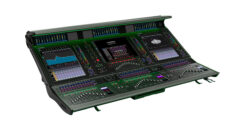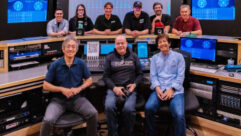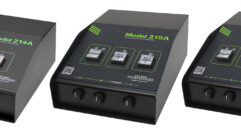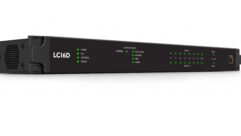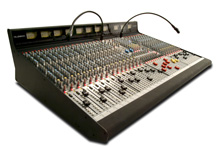

Installation Audio Consoles
Jul 31, 2012 3:49 PM,
By Bennett Liles
Allen & Heath GL3800
It’s a very interesting time in the evolution of installed mixing consoles, with digital boards of every size and shape touting among their many features the ability to operate with an “analog feel.” The analog machines themselves haven’t gone extinct. In fact, they are still thriving and allowing churches and smaller venues to get perfectly good functionality at a lower price point. The consoles surveyed here are used for live FOH, stage monitor, location recording, or broadcast roles.
The GL3800 from Allen & Heath is an eight-bus dual function analog console for FOH, monitor mixing, or location recording. Available in 24-, 32-, 40-, and 48-channel frames, the board has 10 aux outs, a dedicated stereo send, and a 12×4 matrix. Each input channel is equipped with a direct out, and the matrix external inputs have level trim and common input function. Along the top of the mixer is an integral LED-illuminated moving coil VU meter pod. There are mutes and meters on all fader masters along with recessed pre/post-EQ aux switching on each channel. The talkback channel is assignable to all outputs, and the features include a 1kHz tone oscillator and pink noise generator with an external output.

APB Dynasonics ProDesk-8
Using the same plug-in power supply modules as the Spectra series of consoles, the ProDesk-8 medium-format front-of-house console builds on the experience of APB Dynasonics with the company’s Spectra and ProDesk-4 mixers. The ProDesk-8 is available in modular blocks of 24, 32, 40, and 48 mic/line input channels with the 100mm fader input strips providing phase reverse and 48V phantom power. The board has digital USB stereo input and record output along with the ability to remotely mute all primary outputs with a single opto-isolated Phoenix connector in response to an open or closed external relay. There are direct outs on all mono input channels, and the eight aux outputs are pre/post fader switchable in pairs.

Avid Venue SC48 Remote System
Avid offers a variation on its proven SC48 all-in-one mixing console with the new Venue SC48 Remote System, which adds the Venue Stage Remote Box, connecting the two on Ethernet with Cat-5e. The remote unit may be added to an existing SC48 console by moving the I/O cards from the mixer frame to the remote stage box. The box can handle up to 32 inputs and 16 outputs. The mixer offers 16 aux sends, eight groups and eight mono matrixes with 26 touch-sensitive motorized faders and 16 assignable, push-switch rotary encoders with multi-segment LED rings. For Pro Tools, it includes a FireWire port in addition to a GPI port, two footswitch connectors, and five USB 2.0 ports.

Behringer X32
The compact new X32 digital mixer from Behringer is a 32-channel, 16-bus console with programmable Midas preamps, 100mm motorized faders, eight DCA groups, and a 32-channel audio interface and iPad remote control. The board’s rotary knobs have LED collars for low ambient light viewing, and the 800×480 color TFT display allows instant access to eight control screens. The console includes user-definable knobs and buttons along with the capability to save mixes and setups to a USB stick. There is also UltraNet connectivity for the Behringer P-16 personal monitoring system, and each input channel and bus features an LCD scribble strip for identification. The X32 also provides six aux inputs on 1/4in. TRS, 16 balanced XLR outputs, and balanced control room outputs.

Calrec Artemis Light
Designed by Calrec primarily for live broadcast operations, the Artemis Light is the newest member of the Artemis family of Bluefin2/Hydra2 audio consoles and uses the same surface as the larger Artemis consoles, the only difference being the size of the processor rack. The router has eight Hydra2 ports for interfacing with the Hydra2 I/O range, as well as other Hydra2 routers and their I/O. Bluefin2 architecture is used in the Artemis Light DSP to provide 240 input channels that can be assigned as mono, stereo, or surround paths. Up to 16 main outputs and 48 audio groups can be assigned as mono, stereo, or surround from a pool of 72 busses, as well as 48 track and 24 auxiliary output busses.
Installation Audio Consoles
Jul 31, 2012 3:49 PM,
By Bennett Liles

Crest Audio X 20RM
With 12 mono inputs and four stereo inputs, each with a mic preamp and individually switched phantom power, the X 20RM from Crest Audio can perform either at FOH or in the monitor position. There is also a built-in splitter system on each mic/line input and a ground lift switch. An additional stereo common input allows a signal to be sent to all 12 output busses and these can be configured individually as mono outputs or in stereo pairs. The mixer uses a 10-space rackmount configuration and has a solo link system compatible with other X-Series rack mixers. Each input also features four-band semi-parametric mid-sweep EQ, long-throw faders, an 18dB per octave high-pass filter, and channel insert patch points.

DiGiCo SD5
The SD5 console from DiGiCo can handle either broadcast or FOH roles with its new quieter dual redundant power supplies, from which the fans have been removed and replaced with large heat sinks and a single fan that is temperature controlled. The system offers 124 input channels into 56 busses, and these are all controlled through three centrally located touchscreens. There is a 24×24 output matrix, 24 effects, 24 channels of dynamic EQ, 24 multiband compressors, 32 graphic EQs and eight AES/EBU I/O. In addition to the three central touchscreens there are two full color TFT LCD screens for view only. The board offers two interactive dynamic metering displays (IDM) and instant access quick-select buttons.

Innovason Eclipse GT
With a touchscreen, keyboard, and trackball integrated into the work surface, the Eclipse GT from Innovason requires no outboard processing to allow full-featured performance. Each of the console’s stage boxes can be configured with either analog or digital input and output channels, and there is also a redundant Cat-5 and fiber connection on the board. As many as 104 input channels can be sent to 48 mix and two monitor busses, each of which can be used as an auxiliary, a sub group, a master, or matrix. Each input channel has EQ, dynamics, delay, gain trim, and phase reverse. The Smart Panel feature provides a flexible range of configuration while Virtual Soundcheck disconnects all live inputs and feeds multi-track playback to the input channels.

Mackie DL1608
The new MackieDL1608 is made to work with up to 10 iPad devices for wireless mix control from anywhere in the venue, saving time for sound techs in setup and live performance. The DL1608’s Master Fader app allows mix snapshots, channel presets, and stereo recording from anywhere in the venue via iPad. The mixer uses 16 Onyx preamps for 12 XLR and four combo mic/line inputs. Plug-ins on every channel allow control over compression, gating, and four-band EQ while the main and aux outputs add 31-band graphic EQ and limiting. The mixer’s channel presets provide immediate setup with either custom or factory parameters. Features include a Kensington lock for the mixer and PadLock, which secures the iPad on the console.

Midas PRO9
Top of the line of Midas PRO Series consoles, the PRO9 has been laid out to handle large FOH, monitoring, and broadcast audio mixing. While the PRO3, PRO6, and PRO9 are expandable, the PRO9 offers the most comprehensive functionality. The system provides 88 input channels to 35 busses, and its two stage boxes can be placed more than 600ft. apart and more than 1,500ft. from the console. The DL251 fixed-format stage box features the DL431 24-channel five-way mic splitter with three mic preamps per channel and dual digital network connections. Included on the console are eight return inputs, 16 group/aux busses, and 10 VCAs along with six POPulation groups and fiber-optic connections.

Peavey FX32
Peavey offers the FX32 console with Silencer mic preamps, four pre-fader and two post-fader aux busses per channel, and dual DSP engines. The digital output processing section includes Feedback Ferrets, dual five-band parametric EQ or dual 27-band Graphic EQs, digital delay lines, and dynamics/limiters. There are also dual USB ports for live streaming to a computer or memory stick and routable digital input. Each input includes three-band EQ with sweepable mid-frequency and fixed low-cut filters, 48V phantom power, and four sub groups. The digital effects selected are displayed on the console’s LCD screen along with all of the menus available for editing. Utility menu options include LCD viewing adjustments and user access security settings.
Installation Audio Consoles
Jul 31, 2012 3:49 PM,
By Bennett Liles

PreSonus StudioLive 24.4.2
The StudioLive 24.4.2 digital mixer from PreSonus is designed for live sound and recording, using its 24 XMAX microphone preamps on the line/mic input channels, built-in 32×26 FireWire recording and playback interface, 24 input channel send/return inserts, 24 direct outputs, two stereo pairs of aux return inputs and stereo pair of main mix outputs. Additional capabilities include a mono mix out, four-band fully parametric EQs, compressors, limiters, expander/gates, reverb and delay effects, ten aux busses, stereo RCA connector tape outputs, stereo S/PDIF coaxial digital output, eight assignable graphic EQs, and two FireWire 400 ports. There is mixer save/recall, channel-strip save/recall/copy/paste and extensive talkback routing. The StudioLive 24.4.2 comes with Capture software allowing digital multi-track recording from many combinations of the mixer’s outputs. It also comes with PreSonus’ full-featured Studio One Artist DAW and Virtual StudioLive editor/librarian/bidirectional control software with integrated Smaart Spectra audio-analysis features. The entire mixer can be wirelessly remote controlled using free StudioLive Remote for iPad and its aux mixes can be controlled with free QMix for iPhone and iPod Touch.

Roland Systems Group M-480
Billed as the new flagship of the V-Mixing system from Roland Systems Group, the M-480 live mixing console has 48 input channels, six stereo returns, 16 aux busses, eight matrices, and four-band parametric EQ on each input. Along with this, there is gating and compression on each channel and delay on every input and output. For bigger jobs, there is a REAC (Roland Ethernet Audio Communication) cascade connection for a second M-480 to expand the input capacity to 96 channels. The system also provides a post preamp patch point for direct routing from inputs to outputs without going through the console. Using six dual-mono effects processors, the system adds reverb, delay, chorus, pitch shift, and advanced channel strip.

Samson Technologies L3200
Made especially for live sound venues such as theaters, clubs, and churches, the L3200 32-channel/four-bus professional mixing console is equipped by Samson Technologies with large backlit mute buttons, and there are two large 12-segment LED meters for the main mix, groups, and PFL/AFL. Six flexible aux sends provide up to eight monitor and effects mixes along with 1/4in. and XLR main outputs. USB ports can transmit a digital recording mix that is independent of the house sound. The console also features four groups with inserts, three-band EQ with sweepable mids, and dual DSP with 100 digital multi-effects. There is also a mono output, two stereo aux returns, and phantom power; all channels and groups are controlled with 100mm faders.

Soundcraft Live 8
In the realm of analog mixers for live music applications and on-site recording, Soundcraft has produced the Live 8 in four frame sizes from 16 to 40 inputs. The six auxiliary busses can act as monitor or effects sends and four of these, along with the direct outs, can be switched between pre and post fader. The console uses Soundcraft’s UltraMic+ preamps with up to 66dB gain, and it includes a 10×2 matrix, four-band EQ with two swept mid bands, eight group busses, four mute groups, eight stereo returns, and individually switched 48V phantom power on each input channel. The mono inputs also offer 18dB per octave high-pass filters and phase reverse buttons. An EQ switch allows instant comparison between EQ and non-EQ on any source.

Solid State Logic C200 HD
Equipped with large channel information displays, a central data screen with a wide viewing angle and a universally familiar “knob per function” control surface, the C200 HD from Solid State Logic combines modern operator information delivery features with a well-known control scheme. This has made the console friendly to freelance sound ops that may have only minutes to get going with the mixer. Snapshot and dynamic automation make the C200 HD easy to manage in either role. There are 48 multi-track busses with individual gain trim, 12 main busses, two program outputs (5.1 and stereo), independent pre and post fader direct outs, 12 stereo FX returns, and dedicated processing on each channel strip. The digital routing capabilities allow rapid switching between complex setups.

Studer Vista 5 M2
The StuderVista 5 M2 can serve equally well as a broadcast console and as a live sound mixer with all of the Vista 5 features plus the optional addition of integral TFT-based metering. The TFT meter bridge is available to fit either the 32- or 42-fader frame version. A configurable lower area can show bus assignments or surround images. In History mode, it can also show a scrolling audio waveform to indicate signal anomalies for up to 50 seconds. The console maintains the popular Vista 5 features including the color-coded EQ icons, direct access buttons, second-layer channel labeling, control ganging, dedicated copy/paste keys for each audio function, and Vista 5 EQ and dynamics processing.

TOA Electronics D-2000
The D-2000from TOA Electronics can be configured and outfitted for live mixing in small or medium-sized venues using its central processor and separate mixer units. For live mixing, its LAN-connected D-2012C or D-911 remote controllers can be set up with assignable fader layers, scene presets, and control switches. The D2012C has 100mm motorized faders, rotary encoders, and four-segment LED level indicators along with on/off and PFL/AFL for all channels. The D-2008SP processor can accept a wide variety of input, output, and control modules including CobraNet. A single D-2008SP frame can accommodate up to a total of 32 channels of input and/or output.

Yamaha CL Series
Introduced at Infocomm 2012, the Dante network-based CL Series consoles from Yamaha demonstrated 24 mix buses, eight matrix buses, plus stereo and mono outputs, and 16 DCAs. The CL5 provides 72 mono and eight stereo inputs (64 channels through Dante and eight local), with 34 faders (16 on the left, eight Centralogic, and eight right plus stereo and mono masters). The CL1 features 48 mono and eight stereo inputs with 16 faders. As many as eight external Rio (Remote I/O) boxes can be used for a total of 256 channels via the Dante digital network. The rear panel includes three MY card slots, work clock I/O, MIDI I/O, AES/EBU digital out, eight analog omni ins/outs, five-in/five-out GPI, and an external PW800W PSU connection.


